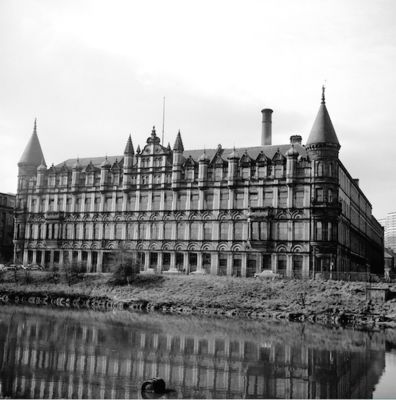
The United Cooperative Baking Society’s bakery, 12 McNeil Street, Moffat Street frontage, 1967.
The first part of the Society’s huge bakery was built at the corner of McNeil Street and Ballater Street in 1886, and it was gradually extended to cover a whole block. This show frontage, facing Glasgow Green, was the last part to be completed, in 1908, and was a superb example of the imaginative use of moulded and multi-coloured brick. It was designed by Bruce and Hay. It was Glasgow’s largest bakery, built to supply bread and other bakery products to retail cooperative societies throughout the city and surrounding areas. The oldest part (seen in the second photograph) was at the corner, built in Flemish style in 1886. The rest of the Ballater Street section was added in 1895-96.
Photo: John R Hume. Yashika 635 twin-lens reflex camera, digital print
© HES
-
Introduction
-
The Regent Flour Mills, Bunhouse Road, Kelvingrove, 1967.
-
The United Cooperative Baking Society’s bakery, 12 McNeil Street, Moffat Street frontage, 1967.
-
The Cranstonhill Bakery, 38-42 Cranston Street, Anderston, 1967.
-
The South Sawmillfield Cotton Mill, 6-12 Burns Street, Port Dundas, 1965.
-
The Saracen Foundry, 73 Hawthorn Street, Possilpark, 1965.
-
The Gorbals Grain Mills, 87-97 Surrey Street, Gorbals, 1966.
-
Townsends’ Chemical Works, 31-33 Townsend Street, Port Dundas, 1967.
-
The Anderston Cotton Work, 93 Cheapside Street, Anderston, 1966.
-
Monumental Sculptors’ Works, 60 Cathedral Street, Townhead, 1967.
-
Pointhouse Shipbuilding Yard, 250 Ferry Road, 1964.
-
Reed and Heddle Factory, 105-111 John Street, City Centre, 1973.
-
The Clyde Foundry, 184 Helen Street, Govan, 1967.
-
Parkhead Forge, G Shop, East Wellington Street, Parkhead, 1967.
-
Concluding Remarks